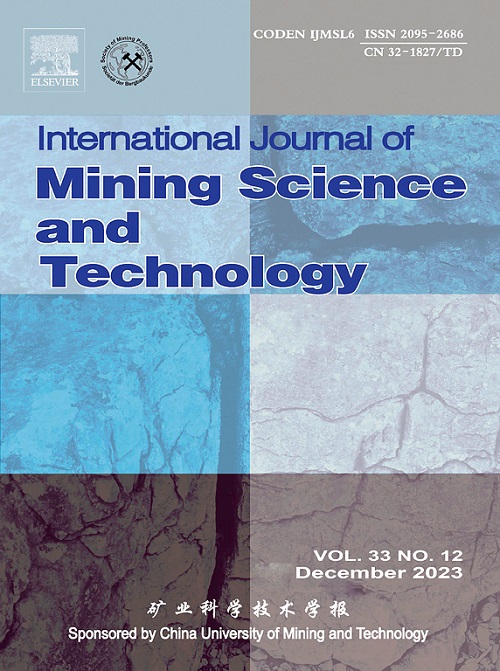Deformation and damage mechanisms of Y-intersecting jointed rocks under uniaxial compression
IF 13.7
1区 工程技术
Q1 MINING & MINERAL PROCESSING
International Journal of Mining Science and Technology
Pub Date : 2025-05-01
DOI:10.1016/j.ijmst.2025.04.005
引用次数: 0
Abstract
This study systematically analyzes the influence of different combined joint dip angles on rock mass failure modes and damage mechanisms through uniaxial compression tests on granite specimens with prefabricated Y-shaped discontinuities, combined with digital speckle and acoustic emission (AE) monitoring. The results show that as the dip angle of the primary joint increases, the failure mode transitions from overall failure to wedge block ejection and shear failure. A failure mode identification model was established based on main crack dip angle thresholds (40°, 45°), uniaxial compressive strength thresholds (40, 90 MPa), and energy core zone proportion thresholds (20%, 10%), achieving an accuracy of 93.3%. In the overall failure and wedge block ejection modes, a sharp increase in shear crack ratio and a sudden drop in the acoustic emission b-value occur in the high-stress phase (>0.6σc), while in the shear failure mode, significant fluctuations are observed due to the shear-tension alternation, making it difficult to identify a single critical point. Additionally, joint slip in the overall failure and wedge block ejection modes primarily occurs during the failure instability phase (>0.8σc). These findings provide theoretical support for stability evaluation of complex fractured rock masses and practical guidance for engineering safety construction.
单轴压缩下y形相交节理岩石的变形与损伤机理
通过对预制y形结构面花岗岩试件进行单轴压缩试验,结合数字散斑和声发射监测,系统分析了不同组合节理倾角对岩体破坏模式和损伤机制的影响。结果表明:随着主节理倾角的增大,破坏模式由整体破坏转变为楔块抛射和剪切破坏;建立了基于主裂纹倾角阈值(40°、45°)、单轴抗压强度阈值(40、90 MPa)和能量核心区比例阈值(20%、10%)的破坏模式识别模型,准确率为93.3%。在整体破坏模式和楔块顶出模式中,高应力阶段(>0.6σc)剪切裂纹比急剧增加,声发射b值突然下降,而在剪切破坏模式中,由于剪切-张拉交替,出现了明显的波动,难以识别单一临界点。整体破坏和楔块抛射模式的节理滑移主要发生在破坏失稳阶段(>0.8σc)。研究结果为复杂裂隙岩体稳定性评价提供了理论支持,为工程安全施工提供了实践指导。
本文章由计算机程序翻译,如有差异,请以英文原文为准。
求助全文
约1分钟内获得全文
求助全文
来源期刊

International Journal of Mining Science and Technology
Earth and Planetary Sciences-Geotechnical Engineering and Engineering Geology
CiteScore
19.10
自引率
11.90%
发文量
2541
审稿时长
44 days
期刊介绍:
The International Journal of Mining Science and Technology, founded in 1990 as the Journal of China University of Mining and Technology, is a monthly English-language journal. It publishes original research papers and high-quality reviews that explore the latest advancements in theories, methodologies, and applications within the realm of mining sciences and technologies. The journal serves as an international exchange forum for readers and authors worldwide involved in mining sciences and technologies. All papers undergo a peer-review process and meticulous editing by specialists and authorities, with the entire submission-to-publication process conducted electronically.
 求助内容:
求助内容: 应助结果提醒方式:
应助结果提醒方式:


